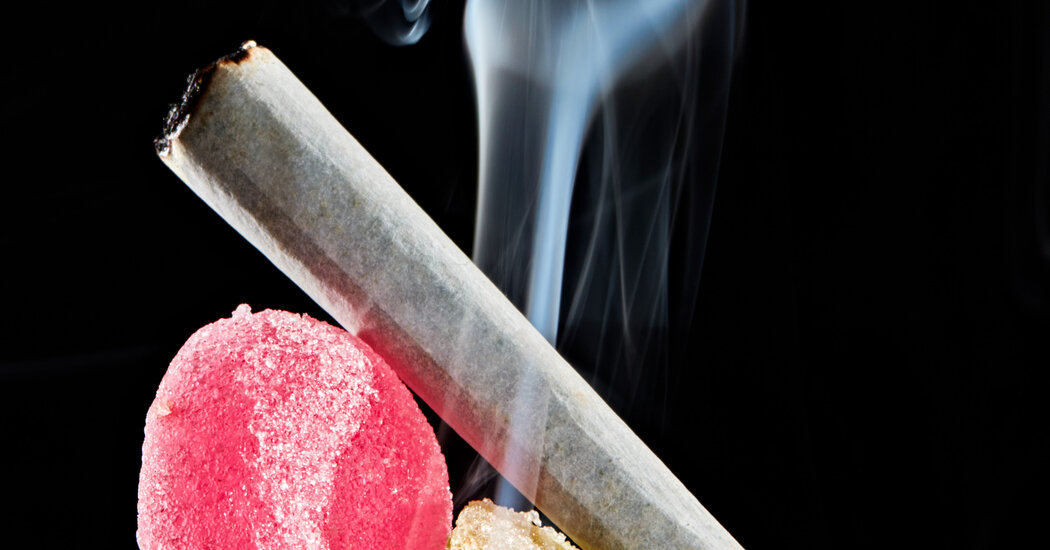Cannabis-infused chocolate fountains are flowing at weddings. “Budtenders” are pouring cannabis cocktails. And as sales of edibles are trending up, cannabis brands are emphasizing the idea that the products might offer a healthier alternative to bongs or blunts.
“Edibles allow you to enjoy cannabis without the negative side effects of smoking,” reads the website of Kiva, which makes cannabis chocolate bars and fruit-flavored gummies.
Consumers are increasingly asking whether that’s the case, but the answer is complicated. There’s little research comparing the health effects of edibles and smoking head-to-head. What we do know so far largely comes from limited data, anecdotes and inferences from researchers and clinicians.
“There’s tons of nuance there,” said Ryan Vandrey, a professor of psychiatry and behavioral sciences at Johns Hopkins Medicine who studies cannabis. “You can’t black and white say edibles are safer than smoking, or smoking is worse than vaping — there are different risks for the different routes.”
Edibles are harder to dose
When someone smokes a joint, the high hits almost immediately and then fades within a few hours. But the cannabinoids in edibles take their time traveling through the gastrointestinal tract. It can take anywhere from 30 minutes to several hours for users to feel the effects, said Daniel Barrus, a pharmacologist at the nonprofit research organization RTI International. That timing can vary even for experienced cannabis consumers, because the contents of your stomach affect how quickly an edible kicks in, said Dr. Collin Reiff, a clinical assistant professor of psychiatry at the N.Y.U. Grossman School of Medicine.
As a result, consumers can end up nibbling an extra bite of a pot brownie or eating another gummy to feel more of an effect — and end up way too high when the drug finally kicks in, sometimes causing paranoia, delusions and panic attacks. These effects typically subside within hours, but people can have rapid, racing heart rates, leading some to seek medical attention.
“I see far more adverse outcomes in people who use edibles,” Dr. Reiff said.
A study of emergency department visits related to marijuana at a large hospital in Colorado found that people who took edibles were more likely to end up in the emergency room. (Total admissions were higher for smokers, most likely because far more people smoked than used edibles, according to state cannabis sales data.) People who took edibles were also more likely to experience cardiovascular or acute psychiatric symptoms, than those who smoked.
Far more people consume edibles safely every day than end up in the hospital, noted Dr. Andrew Monte, a professor of emergency medicine and medical toxicology at the University of Colorado School of Medicine and lead author of the study.
Edibles can lead to more intense highs
Edibles can sometimes induce a more intense, intoxicating high than smoking, because of how the body metabolizes T.H.C., the main compound in cannabis, said James MacKillop, director of the Michael G. DeGroote Centre for Medicinal Cannabis Research at McMaster University.
Even for experienced users, edibles can have a potent effect. For some people, that high can be pleasant; for others, fear and anxiety can take hold.
Edibles may have less addictive potential, Dr. MacKillop said, because in general, the quicker a person feels a drug’s effects, the greater the chance the user will become dependent. A study last year found that roughly one-fifth of people who use cannabis develop cannabis use disorder.
The respiratory risk of smoking
Smoking any substance has the potential to harm your lungs.
Cannabis smoke contains many of the same toxic chemicals and carcinogens as cigarette smoke, and the drug, when smoked, can damage lung tissues and blood vessels, according to the Centers for Disease Control and Prevention. The method also matters: When people smoke a joint or blunt, they also inhale particulate matter from rolling papers or wrappers, as well as particulate matter from the cannabis itself, both of which may harm the lungs.
Vapes heat cannabis through a different method than joints, bongs and pipes, and so vapes can help consumers avoid harmful compounds like carbon monoxide and tar, Dr. Barrus said. But vapes still expose the lungs to irritants, and some evidence has found that vapes generate dangerous emissions. Cases of vaping-related illnesses and injuries caused by contaminants in vapes have concerned doctors for years.
People who smoke cannabis seem to be at an increased risk for bronchitis, and it’s clear that smoke can significantly irritate the lungs, Dr. Barrus said. But studies have not definitively proven that smoking cannabis can cause lung cancer, as smoking tobacco does.







